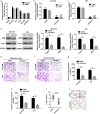Capn4 promotes esophageal squamous cell carcinoma metastasis by regulating ZEB1 through the Wnt/β-catenin signaling pathway
- PMID: 30444080
- PMCID: PMC6312849
- DOI: 10.1111/1759-7714.12893
Capn4 promotes esophageal squamous cell carcinoma metastasis by regulating ZEB1 through the Wnt/β-catenin signaling pathway
Abstract
Background: Capn4 and ZEB1 play important roles in the metastasis of several types of cancer. However, the roles and relationship of Capn4 and ZEB1 in esophageal squamous cell carcinoma (ESCC) remain unclear.
Methods: ESCC tumor tissues and corresponding normal esophageal epithelial tissues were obtained from 86 patients undergoing resection surgery at the Department of General Surgery, First Affiliated Hospital of Chinese PLA General Hospital from 2012 to 2017. Cell migration and invasion were examined via quantitative real-time PCR and Western blot assay.
Results: Our results indicate that both Capn4 and ZEB1 are significantly upregulated in ESCC tissues compared to corresponding adjacent tissues, and a positive correlation between expression and associated malignant characteristics was found. Silencing of Capn4 expression markedly inhibited ESCC invasion and metastasis in vitro and in vivo, and was accompanied by decreased ZEB1 expression. Furthermore, the anti-metastasis role of Capn4 silencing was reversed by ZEB1 overexpression, whereas knockdown of ZEB1 decreased ESCC metastasis driven by the upregulation of Capn4. Mechanistically, Capn4 regulated ZEB1 expression via activation of the Wnt/β-catenin signaling pathway in ESCC cells.
Conclusion: Overall, our results show that enhanced Capn4 expression activates the Wnt/β-catenin signaling pathway, resulting in increased ZEB1 expression and the promotion of ESCC cell metastasis.
Keywords: Capn4; ZEB1; esophageal squamous cell carcinoma (ESCC); metastasis.
© 2018 The Authors. Thoracic Cancer published by China Lung Oncology Group and John Wiley & Sons Australia, Ltd.
Figures




References
-
- Rustgi AK, El‐Serag HB. Esophageal carcinoma. N Engl J Med 2014; 371: 2499–509. - PubMed
-
- Torre LA, Bray F, Siegel RL, Ferlay J, Lortet‐Tieulent J, Jemal A. Global cancer statistics, 2012. CA Cancer J Clin 2015; 65: 87–108. - PubMed
-
- Siegel R, Naishadham D, Jemal A. Cancer statistics, 2013. CA Cancer J Clin 2013; 63: 11–30. - PubMed
-
- Vallbohmer D, Brabender J, Metzger R, Holscher AH. Genetics in the pathogenesis of esophageal cancer: Possible predictive and prognostic factors. J Gastrointest Surg 2010; 14 (Suppl 1): S75–80. - PubMed
-
- Saez ME, Ramirez‐Lorca R, Moron FJ, Ruiz A. The therapeutic potential of the calpain family: New aspects. Drug Discov Today 2006; 11: 917–23. - PubMed
MeSH terms
Substances
LinkOut - more resources
Full Text Sources
Molecular Biology Databases
Miscellaneous

